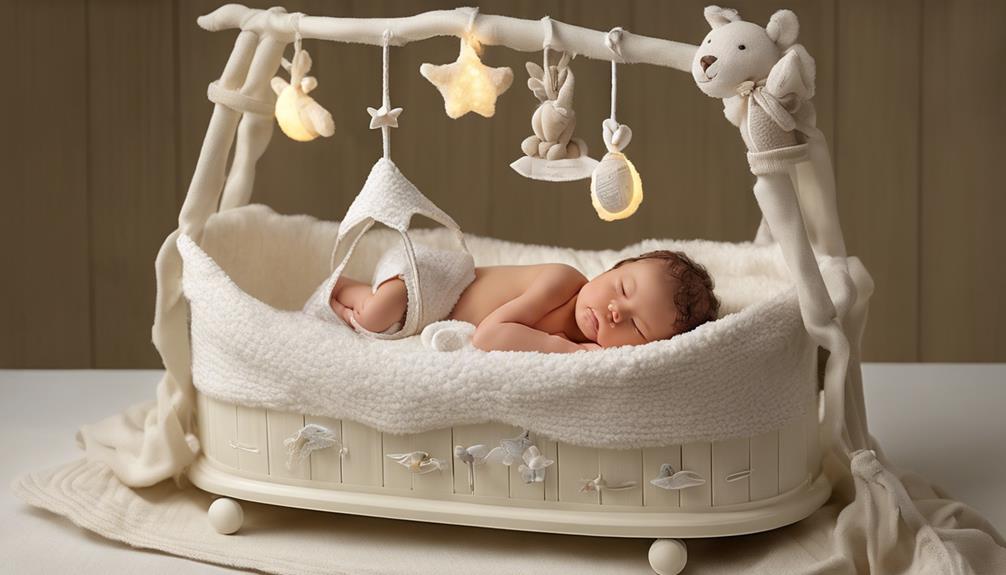Let's face it, the struggle is real when your newborn just won't hit the hay. But fear not, because we're here for you with the top 10 best ways to help your little one catch some Zs.
From mastering the art of swaddling to decoding those sleep cues, there are plenty of strategies to explore.
So, are you ready to discover the secrets to a peaceful night's sleep for both you and your baby?
Key Takeaways
- Establish a consistent bedtime routine for signal sleep time and promote longer, quality sleep.
- Create a relaxing sleep environment with soft lighting, white noise, and warm-colored lights.
- Learn baby's sleep cues like yawning and fussiness to respond promptly for rest.
- Utilize soothing techniques like swaddling and white noise to aid in relaxation and better sleep.
Establishing a Bedtime Routine
To help your newborn sleep better, start by establishing a consistent bedtime routine that signals it's time to rest. A bedtime routine for your baby is like a signal to their little brain that it's time to wind down and prepare for a peaceful sleep. By incorporating calming activities such as a warm bath, gentle rocking, or soft lullabies before bedtime, you can help your newborn relax and feel secure, setting the stage for a restful night.
These rituals not only create a sense of comfort but also assist your baby in learning to self-soothe, making it easier for them to fall asleep on their own. Additionally, a consistent bedtime routine can aid in teaching your newborn the difference between day and night, helping them establish healthy sleep patterns early on. By prioritizing a bedtime routine, you can pave the way for your baby to enjoy longer stretches of quality sleep both during the day and at night.
Swaddling Techniques

When it comes to helping your newborn sleep, mastering swaddling techniques can make a world of difference.
We'll guide you through swaddling for better sleep and demonstrate the proper techniques.
Let's make sure your little one feels snug, secure, and ready for a peaceful night's rest.
Swaddling for Better Sleep
Swaddling newborns properly is essential for creating a cozy and secure sleep environment conducive to longer, more restful nights. When done right, swaddling can help babies self-soothe and feel secure, aiding in preventing sleep regression and promoting better sleep.
Here are three key benefits of swaddling for better sleep:
- Mimics the Womb: Recreating the snug feeling of the womb helps calm babies experiencing the Moro Reflex, allowing them to relax and drift off to sleep more easily.
- Promotes Comfort and Security: Swaddling provides newborns with a sense of comfort and security, making them feel safe and settled, which can lead to improved sleep quality.
- Establishes Bedtime Routine: Incorporating swaddling techniques in the bedtime routine signals to babies that it's time to sleep, helping establish a consistent sleep pattern.
Proper Technique Demonstration
Demonstrating the proper technique for swaddling your newborn can help guarantee a secure and comfortable sleep environment.
When you swaddle your baby, make sure to wrap them snugly in a breathable blanket, starting with one corner and tucking the edges securely.
Keep their arms close to their sides to prevent the startle reflex, providing a sense of security and comfort.
Finding the right balance – not too tight to restrict movement, yet not too loose to come undone easily during sleep.
Creating a Calm Sleep Environment

Creating a calm sleep environment for your newborn is important for promoting restful sleep. Soft lighting choices and controlling noise levels play a significant role in setting the stage for a peaceful slumber.
Soft Lighting Choices
When setting up your baby's sleep environment, choosing soft lighting options like dimmable lamps or nightlights can greatly contribute to creating a calm atmosphere conducive to restful sleep.
Here are three tips for selecting the best lighting choices for your newborn:
- Avoid Bright Overhead Lights: Opt for soft, gentle lighting instead of harsh, bright lights to promote relaxation and signal bedtime.
- Use Warm-Colored Lights: Soft, warm-colored lights can help soothe babies and prepare them for sleep by mimicking the natural dusk.
- Block Out External Light: Invest in blackout curtains or shades to block out external sources of light that may disrupt your baby's sleep patterns.
Creating a soothing environment with the right lighting can make a significant difference in your newborn's sleep quality.
Noise Level Control
Maintaining a quiet sleep environment for your baby is important in promoting relaxation and ensuring restful sleep. White noise can be a game-changer when it comes to controlling noise levels for your little one. It helps mask disturbances and provides soothing background sounds that aid babies in relaxing and falling asleep more easily.
Consistent use of white noise can also create a calming atmosphere that fosters better sleep associations for your baby. This type of noise mimics the sounds your baby heard in the womb, offering them comfort and promoting relaxation. By keeping the sleep environment quiet and incorporating white noise, you can contribute to a conducive setting that supports your newborn's sleep needs.
Understanding Baby's Sleep Cues

Recognizing your baby's subtle cues for sleep is crucial in establishing healthy sleep patterns from the start. Understanding these signals can help you respond promptly to your baby's needs, ensuring they get the rest they require.
Here are some key signs to look out for:
- Yawning and Eye Rubbing: If you notice your baby yawning or rubbing their eyes, it's a clear indicator that they're feeling tired and ready for sleep. These actions are classic signs of fatigue in infants.
- Fussiness and Decreased Activity: A fussy or irritable baby, paired with decreased activity, could mean that they need some quiet time to settle down and drift off to sleep. Creating a calm environment to help them relax is crucial.
- Crying and Overtiredness: Excessive crying, fussiness, or arching of the back might signal that your baby is already overtired. By recognizing these cues early on, you can prevent your little one from becoming too exhausted and support them in getting the rest they need.
Strategic Diaper Changes
To maintain your newborn's sleep remains undisturbed, employing strategic diaper changes is essential for creating a calm and soothing environment conducive to rest. Opting for quick and efficient diaper changes during nighttime can help minimize disruptions to your baby's sleep.
It's important to use gentle and quiet techniques, minimizing stimulation to promote relaxation and prevent wakefulness. Choosing absorbent and comfortable diapers plays a significant role in ensuring uninterrupted sleep for your little one.
Incorporating diaper changes into your bedtime routine can also signal to your baby that it's time to sleep, helping to minimize disruptions and maintain a peaceful atmosphere. By making diaper changes a seamless part of your nighttime routine, you can help your newborn settle back to sleep quickly and effectively, reducing any disturbances that may arise during the night.
Managing Expectations

Understanding the challenges of newborn sleep patterns is pivotal in managing expectations as a parent. Newborns come into the world with irregular sleep patterns which can be quite different from those of adults. Here are three key points to bear in mind when maneuvering your baby's sleep habits:
- Frequent Feedings: Newborns require round-the-clock feeding sessions, as their tiny tummies can only hold small amounts of milk or formula at a time. Expect to feed your baby every few hours, even during the night.
- Days and Nights Mixed Up: It's common for newborns to have their days and nights confused in the beginning. Be patient as your little one adjusts to the new environment and gradually learns the difference between day and night.
- Varied Sleep Patterns: Every baby is unique, and their sleep patterns can vary greatly. Some newborns may take short naps while others might've frequent awakenings throughout the night. Embracing this individuality can help you manage your expectations and adapt to your baby's needs more effectively.
Embracing What Works

Handling the challenges of newborn sleep can be overwhelming, but finding what works best for your baby is crucial to establishing healthy sleep habits. Every newborn is unique, so trying different soothing techniques to see what helps your baby drift off to dreamland is vital.
Swaddling your little one snugly can provide a sense of security and mimic the coziness of the womb, promoting better sleep. Incorporating white noise, like a gentle hum or soft lullaby, can create a calming environment that drowns out disruptive sounds and encourages restful sleep.
Rocking your baby or engaging in soothing movements can help replicate the comforting sensations of being cradled, aiding in relaxation. Offering a pacifier can also be a useful tool in soothing your newborn and assisting them in falling asleep more easily.
Embracing these techniques can help you discover what works best for your precious little one, paving the way for more peaceful nights for the whole family.
Utilizing White Noise

White noise can be a game-changer when it comes to helping your newborn sleep better.
It not only drowns out disruptive sounds but also creates a calming atmosphere reminiscent of the womb.
Using white noise consistently can work wonders in establishing a healthy sleep routine for your little one.
White Noise Benefits
When it comes to helping your newborn sleep soundly, incorporating white noise can be a game-changer in creating a soothing sleep environment. Here's why white noise is beneficial for your baby:
- Relaxation: White noise helps babies relax by masking background noises that can disrupt sleep.
- Soothing Environment: It creates a calming atmosphere similar to the sounds in the womb, promoting better sleep.
- Sleep Cue: Using white noise consistently can establish a sleep cue for babies, signaling it's time to rest.
Effective Sound Levels
Maintaining an appropriate sound level is important when incorporating white noise to create a soothing environment for your newborn's sleep.
White noise, at around 50-60 decibels, can help newborns fall asleep faster and stay asleep longer by drowning out sudden noises and providing a consistent, calming background sound.
This calming effect mimics the sounds babies heard in the womb, promoting a sense of security and comfort.
Placing the white noise machine at a vital distance from the baby's crib is essential to prevent any potential hazards.
Implementing Feeding Strategies

To support your newborn's healthy sleep patterns, it's important to establish effective feeding strategies that cater to their nutritional needs and overall comfort. Here are some key points to take into account:
- Breastfeeding on Demand: Responding promptly to your baby's hunger cues by breastfeeding on demand can help guarantee they receive adequate nutrition and establish a strong milk supply. This approach also promotes bonding and comfort.
- Burping: Remember to burp your baby during and after feeding sessions. This simple step can help prevent discomfort caused by trapped air and reduce the likelihood of spit-up, contributing to a more peaceful feeding experience.
- Monitoring Weight Gain and Diaper Output: Keeping track of your baby's weight gain and diaper output is essential in determining if they're getting enough nourishment. Adequate weight gain and the expected number of wet and soiled diapers indicate that your baby is consuming a sufficient amount of milk or formula for their growth and development.
Seeking Professional Help

In supporting your newborn's sleep and overall well-being, it can be beneficial to seek professional help for valuable insights and tailored solutions to address any sleep challenges they may be experiencing.
Consulting a pediatrician allows you to gain expert advice on understanding your baby's sleep patterns and potential issues. When faced with more complex sleep problems, seeking guidance from a sleep specialist can provide specialized strategies to improve your newborn's sleep quality.
Joining support groups can offer not only emotional support but also practical tips from fellow parents maneuvering similar struggles with their babies' sleep. Enrolling in sleep training programs under professional supervision can aid in establishing healthy sleep routines for your little one.
Identifying and rectifying common mistakes in newborn sleep management with professional assistance can significantly enhance your baby's sleep outcomes and bring relief to exhausted parents. Remember, seeking professional help is a proactive step towards ensuring your newborn gets the rest they need for top-notch development and well-being.
Frequently Asked Questions
How Do I Get My Newborn to Stop Fighting Sleep?
We can help your newborn stop fighting sleep by establishing a consistent bedtime routine, swaddling for comfort, avoiding overstimulation, creating a calming sleep environment, and setting clear sleep cues. These steps promote better sleep habits.
How Can I Stimulate My Newborn to Stay Awake?
We engage with our newborn through play, colors, tummy time, eye contact, and talking. These activities stimulate them, develop muscles, and enhance cognitive skills, keeping them awake and alert. We focus on balancing warmth and alertness for a healthy routine.
How Do I Get My Newborn to Sleepless Nights?
To help your newborn sleep better, establish a consistent bedtime routine, swaddle for comfort, create a soothing sleep environment, minimize stimulation during nighttime changes, and use calming techniques like rocking or offering a pacifier. These methods can foster restful nights.
What Helps With Baby Not Sleeping?
When baby struggles to sleep, we find comfort in swaddling for security, establishing bedtime routines for consistency, using white noise to drown distractions, avoiding overstimulation, and practicing safe sleep habits like back sleeping.
Conclusion
To sum up, remember to implement these 10 tips to help your newborn nap and night-time sleep.
By establishing a bedtime routine, swaddling snugly, and creating a calming sleep environment, you can guarantee your little one gets the rest they need.
Understanding their sleep cues, embracing what works, and seeking support when needed are key.
With these strategies in place, you'll be on your way to a peaceful night's sleep for both you and your baby.









